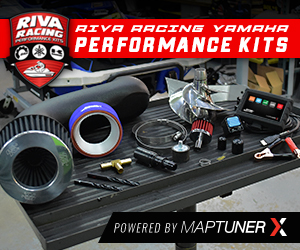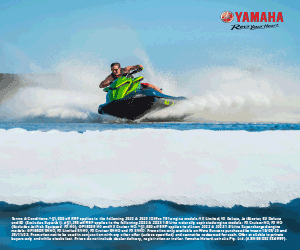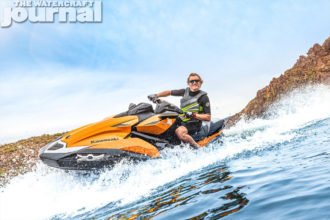
Back in June’s first “Heads Up Showdown” where we pinned the 2018 Sea-Doo RXT-X 300 ($15,699) against the 2018 Yamaha GP1800 WaveRunner ($13,999), we were frankly floored by the results. Despite it’s horsepower advantage, we were certain that the lighter and smaller GP would’ve been the winner. So much so that Jerry teased whether we wished to place a small gentleman’s wager on the outcome. Ironically, both of us would be dumbstruck by the results. The larger, heavier and more-equipped Sea-Doo eked ahead of our Yamaha – if only by fractions of a second. This result not only surprised us, but our readers who struggled to cope with our results.
So when the opportunity to attempt a second “go” at another acceleration test arose, we couldn’t say no. Our reasons for doing so were both mainly scientific, and thereby justified in our experiment, and that we simply had both of these machines in our possession at the time and wanted to see how’d they do when squared off the other. But let’s back up a little; we wanted to revisit our shootout because frankly, many felt that the far larger and heavier ’18 Sea-Doo RXT-X 300 beating out the smaller, lighter and more nimble GP1800 was a fluke. Others – most notably fans of the new Sea-Doo’s “Launch Control” mode – were upset that we chose not to use the feature when battling the Yamaha.

Our reasoning was sound, but left many feeling the comparison was incomplete. “Fair enough,” both The Watercraft Journal’s Kevin Shaw and Jerry Gaddis of Greenhulk.net agreed. So a second bout of testing including runs both with Launch Control engaged and without were planned. Because we had installed a pair of RIVA Racing Pro Series Sponsons months earlier, we swapped the new adjustable sponsons back for the one-piece, molded plastic factory sponsons. And just as we had done back in June, this month’s test would also have both machines topped off with fuel. Yes, this alone was a major point of contention and every manner of sandbagging was suggested to equalize for the weight, but we felt being filled to the top was the most fair and frankly, the least likely solution to spur cries of bias or cheating on our end.
As mentioned, we had in our hands the first 2019 Yamaha WaveRunner FX SVHO (albeit a pre-production unit). The ski itself had nearly 40 hours on the clock, which wasn’t too far off from our Sea-Doo (which also was a pre-production unit), guaranteeing near-equal engine wear and run time. And as last time, we had Jerry be our sole pilot, thereby eliminating any potential differences in rider weight, skill or throttle response. Finally, we employed both a Garmin GPS for tracking top speed as well as a Vbox Sport accelerometer – tracking acceleration times beginning at 5 miles per hour and tracking in 10mph increments. The choice to begin at 5mph was simple: PWC are always in motion, even when set in neutral. Wind, current or the reverse bucket’s redirection of thrust never has the ski at a true zero. Alas, we wanted to be as scientific as possible by eliminating as many variables as we could.

Like we had in June, we drove down to Morgan City, Louisiana to attend the Mudbug, the Fall Mudbug, that is. The second event is far less populated as the summertime event, and doesn’t feature the Speed Alley radar run session on Saturday morning, which was OK by us. We had already scheduled a series of rides with a couple of groups and were looking forward to hours of exploration through miles of shady bayou. Admittedly, most of our casual riding was aboard the Yamaha primarily because we had so little time aboard it and doubted we’d get another opportunity before the beginning of the main riding season next year. So the Sea-Doo sat on the trailer for most of the weekend, that is until it was time to face off against the new FX SVHO on a quiet stretch of canal running a few miles behind Jerry’s home where Greenhulk conducts most of its testing.
Taking the Yamaha first, Jerry sped off into the distance, wanting to get some heat into the engine. The staccato whine of the SVHO’s supercharger howled over the water as the red-and-white WaveRunner slipped across the ever-so-slightly-rippled surface. Then, pausing to set the Vbox and Garmin, he snapped off the first and a sequence of follow-up passes, alternating directions to equate for wind direction and current. He returned to the trailer with a curious look on his face. What was he seeing in the data? we wondered. Without hesitation, the Sea-Doo was next. We remounted and activated the GoPro cameras, the instruments were reset and off Jerry went to repeat the process but on the RXT-X 300. This time though, the Sea-Doo would get a double dose, as Jerry was testing both with and without Launch Control.

The newest feature for the X-series performance Sea-Doos is a little misunderstood. There’s no tapering of throttle or engine response as some have claimed. The “control” in Launch Control is merely articulating the position of the trim nozzle. Activating Launch Control requires being set in Forward motion, as a racer would be at the starting line. When armed, Launch Control trims the nozzle all-the-way down, ensuring the craft won’t leap out of the water upon acceleration. Then, as the ski reaches top speed, the trim nozzle automatically toggles back up to the last preset position, whether that’s at neutral plane or wherever. We agreed with Jerry that a seasoned rider could manually toggle the VTS better, and sought to prove it. The result was everything opposite of our thoughts.
First, the ’18 Sea-Doo RXT-X 300 handily bested the ’19 Yamaha FX SVHO both in 5-30 and 5-60 acceleration speeds, and by a considerable amount. The Sea-Doo carried over a half-of-a-second lead over the WaveRunner, which in drag racing terms, is considerable. If weight was a factor, it didn’t show here. In fact, in stock trim, the RXT-X is only 10-pounds heavier than the FX SVHO (828lbs. vs. 818lbs.); albeit equipped with the BRP Premium Sound system (weighing 19-pounds), fully fueled, the Sea-Doo tipped the scales a 942-pounds, the Yamaha coming in at 930-pounds, effectively closing the gap between the two quite a bit. Yet, despite being heavier and more equipped, the sheer grunt of the Sea-Doo’s 300-horsepower was enough to compensate and earn the ski yet another win.
















Disagree – I outrun the stock RXT-X 300 all the time on my GP1800 and it is stock.
And are you equal weight with the other rider? Have the same amount of gas? Carrying the same amount of storage? Equally stock tuned? Drag races hardly prove equality.